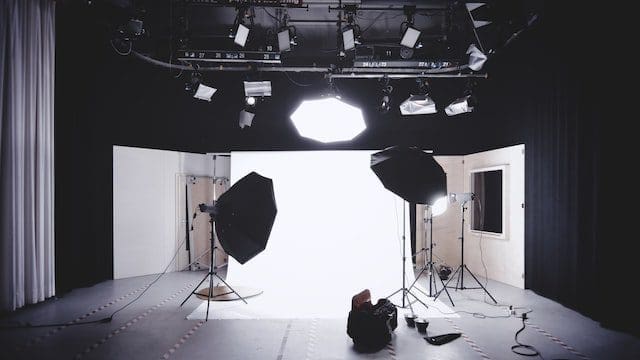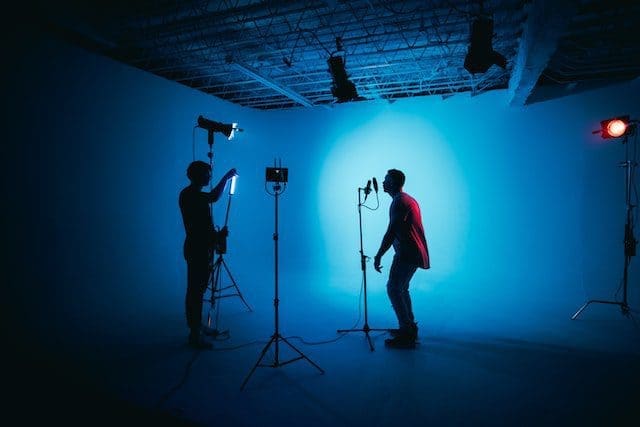Recording studio lighting is an essential aspect of the recording process. It helps create the right atmosphere and ambiance and can also be used to create a certain mood or tone. Different types of lighting can be used to achieve other effects, from soft and subtle to bright and dramatic. Different lighting techniques can also be used to create a sense of depth and space in a studio. Proper lighting can also create a comfortable environment for the musicians and engineers working in the recording studio.
We will unpack all the recording studio lighting essentials today in this article, and I hope we haven’t missed anything out.
Softboxes
Softboxes are a popular choice for recording studio lighting. Softboxes are a type of light modifier that diffuses the light from a lamp or bulb, creating a softer, more even light. They’re typically used for portrait photography, but they can also be used in recording studios to create a more even light that won’t create harsh shadows or glare. Softboxes are available in a variety of sizes and shapes, and they can be used with a variety of lights, including tungsten, fluorescent, and LED. Softboxes can also be used with a variety of light modifiers, such as umbrellas, snoots, and barn doors. Softboxes are an excellent choice for recording studio lighting because they create a soft, even light that won’t create harsh shadows or glare, and they can be used with a variety of lights and modifiers to create the desired effect.
Umbrellas
Umbrellas can be used to diffuse light from a studio light source, such as a strobe or continuous light source. This helps to spread the light out more evenly and soften shadows. To use an umbrella, simply place it between the light source and the subject. This will help to create a more even lighting effect.
LED Lights
LED lights are great for general lighting in a recording studio, as they provide a bright, even light that can be used to illuminate the entire room. They are also energy efficient, so you won’t have to worry about high electricity bills. You can use LED strip lights or individual LED bulbs to provide general lighting in your recording studio.
Barn Doors
Barn doors are a popular lighting tool used in recording studios to control the direction and spread of light. They are typically attached to the front of a light fixture, and can be adjusted to shape the light in various ways. To use barn doors in a recording studio, start by attaching the barn doors to the front of your light fixture. Adjust the barn doors to create the desired shape of light, such as a narrow beam or a wide spread. Experiment with different angles and distances to achieve the desired effect. Barn doors can also be used to control the amount of light that reaches the subject, allowing you to create a soft, diffused look or a more focused, dramatic look. Finally, use gels or colored filters to add color and create interesting lighting effects.
Diffusers
Using diffusers in a recording studio lighting setup can help to create a soft, even light that is flattering to the artist and reduces the harsh shadows that can be created by direct lighting. Diffusers can be used in combination with other light modifiers such as umbrellas, softboxes, and barn doors to create the desired lighting effect. Placing diffusers in front of the lights can help to spread the light evenly and soften the shadows, while diffusers placed behind the lights can help to create a more natural, ambient look. Diffusers can also be used to reduce the intensity of the light, providing a more comfortable environment for the artist.
Reflectors
Reflectors are an important tool for recording studio lighting. They can be used to bounce light onto a subject to create a softer, more even light. They can also be used to fill in shadows and reduce contrast. To use a reflector, simply place it in front of the light source and angle it so that the light bounces off the reflector and onto the subject. If the light is too harsh, try diffusing it with a translucent material such as a white sheet or a diffusion panel. Reflectors can also be used to create more interesting lighting effects, such as cross-lighting or backlighting. Experiment with different angles and distances to achieve the desired effect.
Gels
When using gels in recording studio lighting, the first step is to set the mood. Gels can be used to create a wide range of different lighting effects, from subtle, warm tones to bold and vibrant colors. Consider the desired atmosphere, mood, and aesthetic of the recording session before selecting the colors and types of gels to use.
Stand Mounts
Stand mounts are a great way to light a recording studio. They allow you to adjust the height and angle of the light, which is important for creating the right atmosphere and capturing the best sound. They also provide flexibility as you can move them around the room to create different lighting effects. Stand mounts are usually used with softboxes or umbrellas, which can help to diffuse the light and create a more even distribution. Additionally, they can be used with a variety of different lights, such as LED, fluorescent, and halogen. This makes them a great choice for any recording studio.
Hot Lights
When setting up lighting in a recording studio, it is important to start with the basics. Start by setting up the main lights, such as overhead lights, key lights, and fill lights. These will provide the main lighting for the room and will be used to illuminate the artist and their instruments.
Fresnel Lights
The first step to using Fresnel lights in a recording studio is to set up the lights. You should place the lights at different angles and distances to create the desired effect. You can also use gels and other accessories to modify the lights.
Closing Thoughts
Well, there you go! This is everything you will need in terms of the best recording studio lighting essentials. Enjoy creating your next record in the best light!












